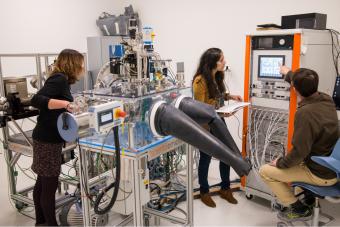Controlling a subtle chemical impurity could hold key to more stable halide perovskite solar materials
Mines researchers teamed up with NREL, Hunt Perovskite Technologies on the findings published in ACS Energy Letters

Colorado School of Mines is home to an Environmental X-ray Photoelectron Spectrometer, shown here, which allows researchers to study material changes in new ways and expose them to light and gases. In this case, the team used the spectrometer to accelerate experimentation through the use of high intensity light, equivalent to 10 suns of power.
Halide perovskites are one of the most exciting new photovoltaic materials under development, promising for their remarkable ease in making high-quality materials with low cost and scalable manufacturing methods. But stability and durability issues continue to pose challenges to their future commercialization.
To solve that problem, researchers from Colorado School of Mines have teamed up with the U.S. Department of Energy’s National Renewable Energy Laboratory (NREL) and industry partner Hunt Perovskite Technologies of Dallas.
With support from the DOE Solar Energy Technologies Office (SETO), the research team recently demonstrated that the stability of these perovskites can be increased up to ten times by controlling a subtle but important chemical impurity. Their findings were published last week in the journal American Chemical Society Energy Letters.
“Hybrid perovskite photovoltaics are one of the most promising new technologies and have made gains in champion cell performance at astronomical rates. However, stability remains a show-stopper for the technology,” said co-author Angus Rockett, professor and head of the Metallurgical and Materials Engineering Department at Mines. “This paper reports a detailed study of the fundamental mechanisms of degradation which can lead to solutions. If these device stability issues can be solved, it has the potential to dramatically improve the performance of solar cells with little additional cost of fabrication.”
Distinctly different from traditional silicon-based solar materials, perovskites can be made from solutions and cast into films on many types of surfaces and at high speed. With their conversion of solar to electrical energy already over 25 percent efficiency, scaling up the technology hinges upon researchers’ ability to increases perovskite tolerance to environmental conditions.
Enabling the team’s discoveries was a major new instrument acquired by Mines, an Environmental X-ray Photoelectron Spectrometer, which allows researchers to study material changes in new ways and expose them to light and gases. In this case, the team used the spectrometer to accelerate experimentation through the use of high intensity light, equivalent to 10 suns of power.
“It really is challenging to study solar cell changes on monthly and yearly timeframes,” said fellow Mines co-author K. Xerxes Steirer, research assistant professor of physics. “Our accelerated tests enabled us to identify the larger impacts of material composition on their stability very quickly.”
Specifically, that helped researchers realize the impact of a specific impurity, called triiodide, was a lot worse than suspected. “When light hits it, the impurity attacks the HP material and generates more of the same impurity. This is a photocatalytic response and our paper was able to demonstrate it,” Steirer said. “It was teamwork that made this discovery possible. The expertise and know-how from the Hunt team led by Chief Technology Officer Michael Irwin and the broad knowledge provided by NREL’s Joseph Berry, director of the US Manufacturing Advanced Perovskites Consortium, gave us direction to follow our early suspicions as we screened materials for photostability.”
“This paper clearly demonstrates our early strategic decision to address the most critical issue to perovskite PV commercialization: fundamental durability,” said Dr. Michael D. Irwin, chief technology officer for Hunt Perovskite Technologies. “We are excited to share this peer-reviewed publication with the scientific community. Colorado School of Mines and NREL provided an excellent collaboration experience with exceptional researchers, specialized environmental XPS instrumentation and scientific understanding, and this paper will serve a strong foundation to take our work to the next level.”
First author on the paper was Anthony Donakowski, now a Mines graduate student pursuing a master’s degree in materials science. At the time of the research, Donakowski was an undergraduate student. “Anthony really shined – the software code he wrote to analyze the thousands of measurements sped up the whole process and helped create an efficient feedback loop with our collaborators,” Steirer said. “Completing a first author publication as an undergrad is a big accomplishment.”
Said Donakowski: “I want to thank the entire team for this invaluable experience. I feel such pride knowing our work can contribute to the future of renewable energy. I'm looking forward to applying the analysis routines to my work at NREL."
To read the full paper, “Improving Photostability of Cesium-Doped Formamidinium Lead Triiodide Perovskite,” go to https://pubs.acs.org/doi/10.1021/acsenergylett.0c02339. This work is funded by the U.S. Department of Energy Solar Energy Technologies Office, under Award Number DE-EE0008540.




